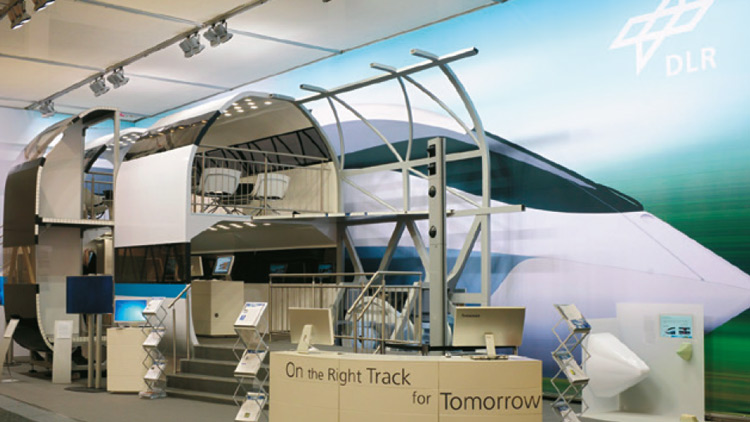Ultra-High-Speed Train Set
The DLR develops concepts to show the trends and technologies for future rail vehicles. The main goals of the Next Generation Train (NGT) project are shorter travel times and reductions in specific energy consumption, noise emissions, and wear, while increasing passenger safety and comfort and reducing life cycle costs. To achieve these goals, an operational concept with a family of high-speed trains was developed: the 400 km/h passenger train NGT HST, using the main high-speed lines, and the 230 km/h intercity train NGT LINK, to take passengers from the surroundings to the NGT HST.
NGT HST is designed as a full double-decker electrical multiple unit (EMU) consisting of two end coaches and eight centre coaches. The train is 202 m long and offers seating for 790 passengers in two classes. The 20 m length of the center coaches as well as the running-gear layout with two single-wheel pairs per coach, is the result of a methodical concept evaluation and represents an optimum lightweight design. In order to implement this concept, many light-weighting measures must be taken, from the structure of the coach and its running gear to the design of the interior.
Through the use of single coaches, each coach remains separable and can be driven individually, a considerable advantage during shunting and maintenance.
The centre coaches have continuous corridors on both levels and through the gangways between the coaches. Thanks to doors on both levels, passengers can board and exit on both levels, eliminating the need for stairs within the train. Luggage can be checked and is automatically sorted and carried separately in the end coaches. In order to guarantee quick changeover times, doors are placed according to passenger behaviour analyses.
Several EMUs can be virtually coupled together, thus increasing operational flexibility. This remote, contactless coupling functionality allows trains to rendezvous while travelling at cruising speed. With the introduction of flexible block distances as a principle of railway safety, this would enable a further increase in line capacity.

The energy supply for NGT HST is integrated into the track, eliminating the need for a maintenance-intensive catenary. The propulsion concept is based on inductive power transfer from the track to receivers distributed over the length of the train. The pantograph is normally a significant source of wear and noise, and this system renders it unnecessary.
The end coaches generate approximately 50 per cent of the train’s 18 megawatts of propulsive power using permanent magnet motors and a pair of independent-wheel bogies. The remainder of the power needed is generated by highly integrated motors built into the center coaches’ mechatronic running gear.
NGT HST will be driven using a predictive assistant programme. The braking concept provides various systems being used in different speed regimes. At high speeds, aerodynamic drag combined with regenerative braking provides deceleration, whereas at lower speeds linear eddy-current brakes and finally mechanical brakes can be used as needed.
